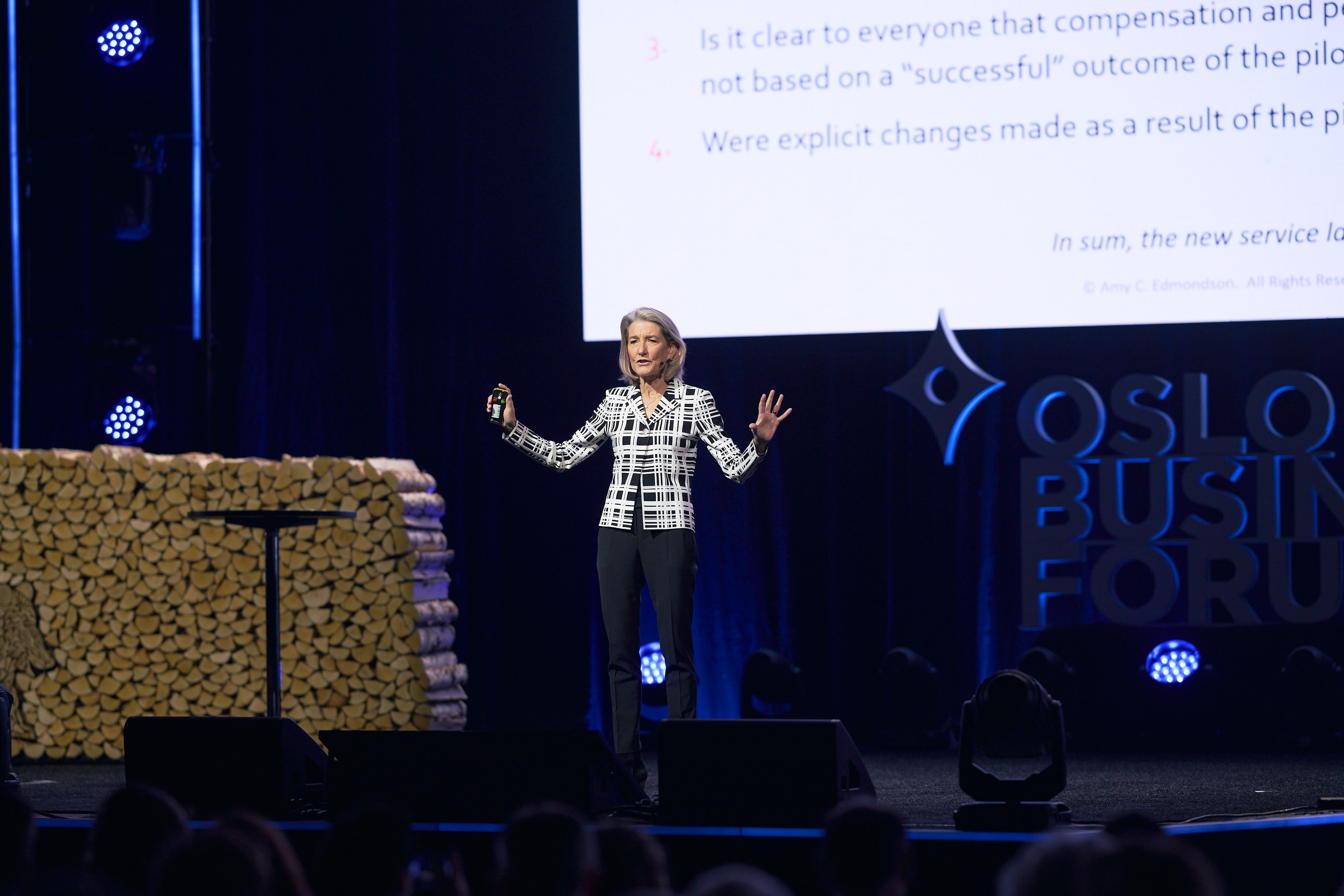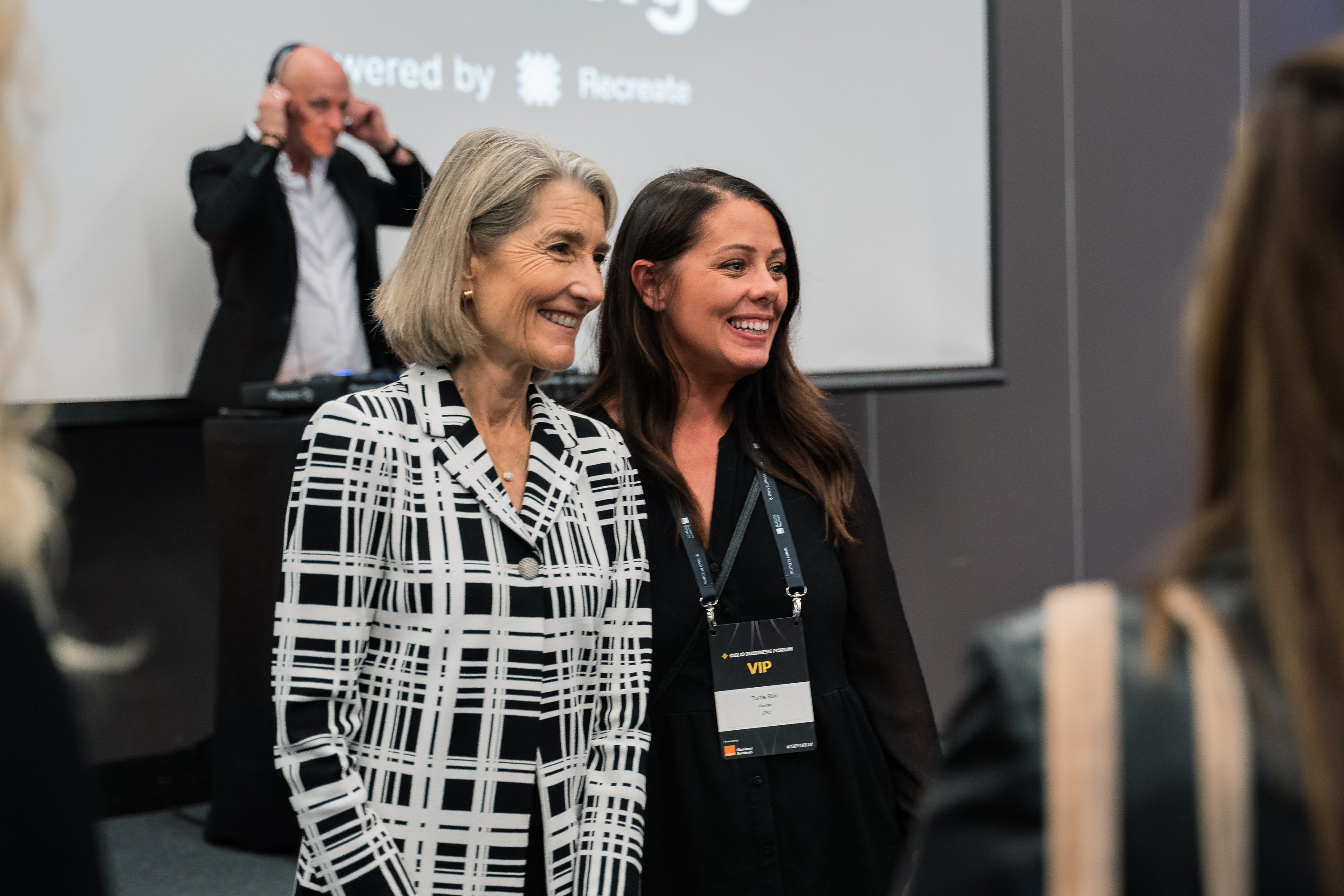At Oslo Business Forum, Harvard professor Amy Edmondson explored interpersonal fear at work, how to combat that fear by building psychological safety, and why every leader needs to think like a scientist.
We choose the best experts in the world to share their knowledge with you. By listening to these top speakers share their success stories and expertise in business and leadership, you can gain ideas and inspiration to develop your organization.
Interpersonal fear at work
Amy describes herself as a social psychologist who has stumbled upon insights related to interpersonal fear, why it's so widespread, and why that matters. To demonstrate fear at work, she took the audience at Oslo Business Forum on a journey back to the dawn of the industrial era and an assembly line at the Ford Motor Company.
At Ford, scientific management significantly decreased the cost and effort of making a car. Many leaders might assume that an organization capable of accomplishing such a feat is a fearless organization—but this was not the case at Ford. Rather, fear was rampant.
Over the course of history, we've seen that fear can work as a motivator. But Amy suggests that it only works when two conditions are present:
- The work is absolutely standardized and precise, and
- The work is done modularly, by individuals with no need for communication and coordination with others.
Amy asked the crowd, "How many of you have those two criteria in place today?" Not a single hand at the Forum went up.
This isn’t surprising, considering the new realities leaders are confronting today. Their awareness and appreciation of novelty, uncertainty, and interdependence have been heightened. But despite this enhanced awareness, their behaviors don't reflect a deeper understanding.
This may be because we've been socialized to hold back—but if we want to create fearless organizations, we can’t afford to play it safe.

Fearlessness in hierarchy
Particularly in hierarchical organizations, teams are hard-wired to err on the side of safety. No one wants to appear ignorant, incompetent, or negative. We care what others think of us, and especially what the "higher-ups" think of us. This is the subtle nature of interpersonal risk at work.
Fear inhibits people from speaking up, discourages them from asking questions, and prevents them from expressing dissent. In a novel, complex, and uncertain world, this puts our businesses at risk.
In some organizations, interpersonal risk is even less subtle. In certain environments, presenting bad news and stating disagreement becomes an unpleasant and demeaning. Oftentimes, this is where high standards rule and leaders value results above all else.
"Stretch goals plus closed ears equals a recipe for failure," said Amy. "You must find a way to have wide open ears."
What is psychological safety?
The subtle and not-so-subtle presence of interpersonal risk at work has been Amy's driving influence to study a concept taking increasing hold in society and business: psychological safety.
- Psychological safety is a sense of permission.
As Amy describes it, psychological safety is when impression management takes a back seat. It is both the belief and expectation that you can speak up. At work, this may take the form of disagreeing with the boss, admitting that you made a mistake, or pointing out a failure you saw. Put simply, psychological safety is a sense of permission.
Amy recognizes that when any topic begins trending, it fosters misconceptions. To debunk the myths surrounding psychological safety today, she pointed out that it is not:
- Being nice
- Job security
- A guarantee that all ideas will be applauded
- A license to whine
- Freedom from conflict
- Permission to slack off
Combatting these perceptions requires a delicate balance between permission and standards. Amy's firm belief is that leaders have two jobs: one is to uphold high standards, and the other is to create a learning environment, or an environment of safety. She has charted effort on these two axes into four domains:
- When both standards and safety are low, teams fall into the Apathy Zone. Essentially, they "quietly quit," putting forth minimal effort.
- When standards are low and safety is high, teams fall into the Comfort Zone. They become complacent, believing they don't have to work too hard.
- When standards are high and safety is low, teams fall into the Interpersonal Anxiety Zone. They are motivated but afraid to ask for help or point out a risk.
- When both standards and safety are high, teams fall into the High-Performance Zone. This is utopia. It’s where we're driven by ambition and permission to reach new heights.

- In study after study, psychological safety is predictive of performance in teams.
Amy was careful to point out to leaders at Oslo Business Forum that psychological safety isn’t actually the goal or end state. Leaders must think of their target in the context of their business. For some, the goal may be quality improvement. For others, it may be innovation.
She shared an example in which researchers explored organizations in the same industry, all engaged in the pursuit of improved quality. As the teams executed their QI work, the researchers uncovered a startling finding: the status of someone's role was a statistically significant indicator of whether their voice was heard. And the researchers saw a pattern that was not consistent across all organizations: in those companies where leaders at the top reacted openly to people in low-status roles speaking up, their results increased.
This demonstrates that hierarchy is not necessarily bad or dangerous, but what matters is how people at the top respond to others.
Measuring psychological safety in your team
With the understanding that psychological safety inspires results, leaders are likely to ask how to create and measure it. Amy offered a simple test to identify whether your teams have psychological safety. Ask yourself how often you hear:
- Good news vs. Bad news
- Progress vs. Problems
- Statements vs. Questions
- Agreement vs. Dissent
- "All's well" vs. Requests for help
If your answers lean to the left, it may feel good to lead this team. "But chances are, you're missing something," said Amy.
The very nature of a leader's role puts them at risk of not having access to the truth. The interpersonal fear that people perceive—or the psychological safety they don’t feel—often causes them to hold back. Their failure to speak up puts their teams and organizations at risk.
Simple steps to create psychological safety
Amy offered leaders at Oslo Business Forum three simple steps to create an environment of high performance and high psychological safety:
- Frame the work. Set the stage for the work to be done. Build a shared understanding of the novel, complex, and uncertain path that lies ahead—and what it requires.
- Invite participation. The most effective way to open the door is to ask good questions. Allow teams to explore situations together and arrive at the best plan. Amy believes a good question is one that focuses us on an issue that matters and invites careful thought (for example, "what are we missing?" or "who has a different perspective?").
- Respond productively. Because response from the top matters, it’s important to listen and express appreciation. Amy encouraged leaders to seek consent versus consensus—because consent sends the message that it's safe to try.
Amy acknowledged that putting these steps into practice is not easy but offered leaders a way to "boil it down" by equating the steps to three crucial leadership traits:
- Frame the work = Humility
- Invite participation = Curiosity
- Respond productively = Empathy

Think like a scientist
In closing, Amy invited participants at Oslo Business Forum to think like a scientist. In contrasting the roles of a traditional manager and a lead scientist, she pointed out that:
- A manager brings answers, while a scientist brings questions.
- A manager specifies results, while a scientist provides direction.
- A manager monitors and evaluates while a scientist empowers and helps make sense of data.
- A manager rewards meeting targets, while a scientist welcomes failure and celebrates discovery.
And most importantly …
- A manager is not dependent on psychological safety, while a scientist is.
As leaders, perhaps shifting our response is the key to creating a fearless environment equipped for greater creativity, problem-solving, innovation, and success. It will help us work together, aim high, fail well, learn fast, and repeat.
Key Points
- We've been socialized to hold back, but we can’t play it safe if we want to create fearless organizations.
- Fear inhibits people from speaking up and in a complex and uncertain world, this puts our businesses at risk.
- Psychological safety is a sense of permission—to speak up, ask questions, and express dissent.
- In the High-Performance Zone, both performance standards and psychological safety are high and teams are driven by ambition and permission to reach new heights.
- The three steps leaders must take to create psychological safety are: frame the work, invite participation, and respond productively.
- As leaders, shifting our response will help us work together aim high, fail well, and learn fast.
Questions to Consider
- What will you do on your team to reinforce the message that anyone's voice can make a difference?
- What steps can you take to ensure engagement? Does your current environment allow for asking good questions and insisting on dissent?
- As people engage, are you prepared to respond productively and create a space where people feel safe to share bad news or admit mistakes?
.jpg?width=7998&name=Sketchnote_DayTwo_Mainstage_AmyEdmonson%20copy%20(1).jpg)
Want to be a part of the OBF community? Join Oslo Business Forum 2023: Thriving in Chaos now!.png?width=680&name=CTA_2023%20(2).png)